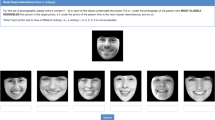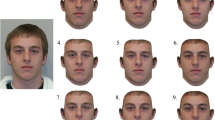Abstract
This study attempted to determine whether people who live with each other for a long period of time grow physically similar in their facial features. Photographs of couples when they were first married and 25 years later were judged for physical similarity and for the likelihood that they were married. The results showed that there is indeed an increase in apparent similarity after 25 years of cohabitation. Moreover, increase in resemblance was associated with greater reported marital happiness. Among the explanations of this phenomenon that were examined, one based on a theory of emotional efference emerged as promising. This theory proposes that emotional processes produce vascular changes that are, in part, regulated by facial musculature. The facial muscles are said to act as ligatures on veins and arteries, and they thereby are able to divert blood from, or direct blood to, the brain. An implication of the vascular theory of emotional efference is that habitual use of facial musculature may permanently affect the physical features of the face. The implication holds further that two people who live with each other for a longer period of time, by virtue of repeated empathic mimicry, would grow physically similar in their facial features. Kin resemblance, therefore, may not be simply a matter of common genes but also a matter of prolonged social contact.
A. L.
Dear A. L.: As far as physical appearance is concerned, likes seem to attract. Some experts feel that this resemblance may partly be explained by the fact that couples who've lived together for some time usually eat the same diet and share the same habits.
The Joyce Brothers Column
April 1985
Similar content being viewed by others
References
Burgess, E. W., & Wallin, P. (1953).Engagement and marriage. New York: Lippincott.
Dimberg, U. (1982). Facial reactions to facial expressions.Psychophysiology, 19 643–647.
Fridlund, A. J., & Gilbert, A. N. (1985). Emotions and facial expression.Science, 230 607–608.
Hoffman, M. L. (1985). Interaction of affect and cognition in empathy. In C. E. Izard, J. Kagan, & R. B. Zajonc (Eds.),Emotion, cognition, and behavior. Cambridge: Cambridge University Press.
Rushton, J. P., Russell, R. J. H., & Wells, P. A. (1985). Personality and genetic similarity theory.Journal of Social and Biological Structures, 8 63–86.
Spuhler, J. N. (1968). Assortative mating with respect to physical characteristics.Eugenics Quarterly, 15 128–140.
Stanton, M. (1924).The encyclopedia of face and form reading. Philadelphia: Davis.
Vandenberg, S. G. (1972). Assortative mating, or who marries whom?Behavior Genetics, 2 127–157.
Waynbaum, I. (1907).La physionomie humaine: Son mécanisme et son role social. Paris: Alcan.
Zajonc, R. B. (1985). Emotion and facial efference.Science, 228 15–21.
Author information
Authors and Affiliations
Additional information
This work was supported by Grant BNS-8505981 from the National Science Foundation. We wish to thank all those who offered their photographs for the purposes of this study, and Joseph R. Zajonc for his helpful suggestions.
Rights and permissions
About this article
Cite this article
Zajonc, R.B., Adelmann, P.K., Murphy, S.T. et al. Convergence in the physical appearance of spouses. Motiv Emot 11, 335–346 (1987). https://doi.org/10.1007/BF00992848
Issue Date:
DOI: https://doi.org/10.1007/BF00992848




